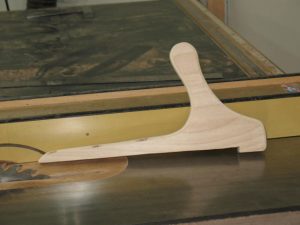We may receive a commission when you use our affiliate links. However, this does not impact our recommendations.
 The push stick you use with your table saw is an integral part of the safety system that helps keep you out of harm’s way. As such, don’t take the lowly push stick for granted. There are numerous push stick styles and designs, some shop-made and others store-bought, but in my view, not all push sticks offer the same level of safety.
The push stick you use with your table saw is an integral part of the safety system that helps keep you out of harm’s way. As such, don’t take the lowly push stick for granted. There are numerous push stick styles and designs, some shop-made and others store-bought, but in my view, not all push sticks offer the same level of safety.
Pictured is the style push stick I’ve relied on for years. It’s made from 3/4″ hardwood plywood and is about a 12″ long and 6″ wide (from the bottom to top of the handle). I keep a 3/8″ heel near the back on the bottom to hook the wood that’s being pushed along. I don’t apply any sort of finish so it grips well. I route a 1/4″ round-over everywhere except the bottom where it contacts the wood when in use. The grip or handle is angled forward slightly so my wrist is in a comfortable position. Those are the comfort/ergonomic reasons I like this style.
But more important are the features that I believe are vital to keeping me safe when I’m pushing narrow stock through the saw. We all know kickback is a real hazard that can often lead to serious injury. This push stick helps prevent kickback. It does this by applying downward pressure on the stock. 
As you know, when a kickback occurs, the stock binds then rises up over the saw blade teeth on the outfeed side of the table. The rim speed of the blade hurls the stock at you. In the worst of cases, your hand is dragged into the blade. So to the degree you can keep the stock down flat on the table, you can help prevent kickback.
The other safety element is the handle position that keeps your hand elevated above the blade – assuming you follow the rule to set the blade height no more than a 1/4″ or so above the stock. And the angle of the handle assures you are applying downward pressure as well as pushing pressure. I also make it a habit to slightly angle the push stick toward the table saw fence. This keeps the stock tight against the fence, another important part of kickback prevention.
(Note: After posting, there were several requests for a full-size drawing. You can download one now by clicking the link. You may need to fuss with your printer settings to so it doesn’t scale the drawing to fit within the default margins, but if you don’t do that, the reduction is very slight. Push Stick Drawing)
Here are some supplies and tools we find essential in our everyday work around the shop. We may receive a commission from sales referred by our links; however, we have carefully selected these products for their usefulness and quality.









When cutting small strips, or ‘rabbits’, etc., I attach a handle to the top(4″ side) of a 6″ piece of 2×4. This creates a great sacrificial push stick that exactly matches the cutoff and has a safety margin on the other side of the blade. A ‘rabbit’ on the forward end of the 2×4 holds down your workpiece.
I also use a push stick – everytime. My design has a fully enclosed handle similar to a standard hand saw. Also my push stick is longer by about 2-3 inches and about one inch taller along the front. . Very confortable and the imagined additional security of having wood in front of my hand adds to my comfort.
That’s a good looking pushstick.
It’s similar in shape to the off-the-shelf Benchdog plastic stick I use. The thing I like about that stick is it has a rubber “tread” underneath the horizontal surface that helps grip the workpiece, so you can really get it good and tight with the rip-fence. It something similar might make a nice upgrade for your stick.
Cheers,
Niels
Steve : A full size pattern of your push stick sure would help us youngsters.
Ed
Something else that works to protect from kickback is an aftermarket over-arm blade protector. I use the Excalibur which I like ’cause you can easily swing it out of the way when using a sled. Should kickback occur anyway, the side shield of the Excalibur prevents your hand from being snatched into the blade.
Steve : Morning, Great advice maybe you could post a full size pattern of your push stick I could add to my collection…Thank You………..jimmyp
Great advice Steve,this is the style of
push stick I use too.The cheap plastic
push sticks are only good for stirring
paint in my opinion and have no place
on a table saw. ;0)